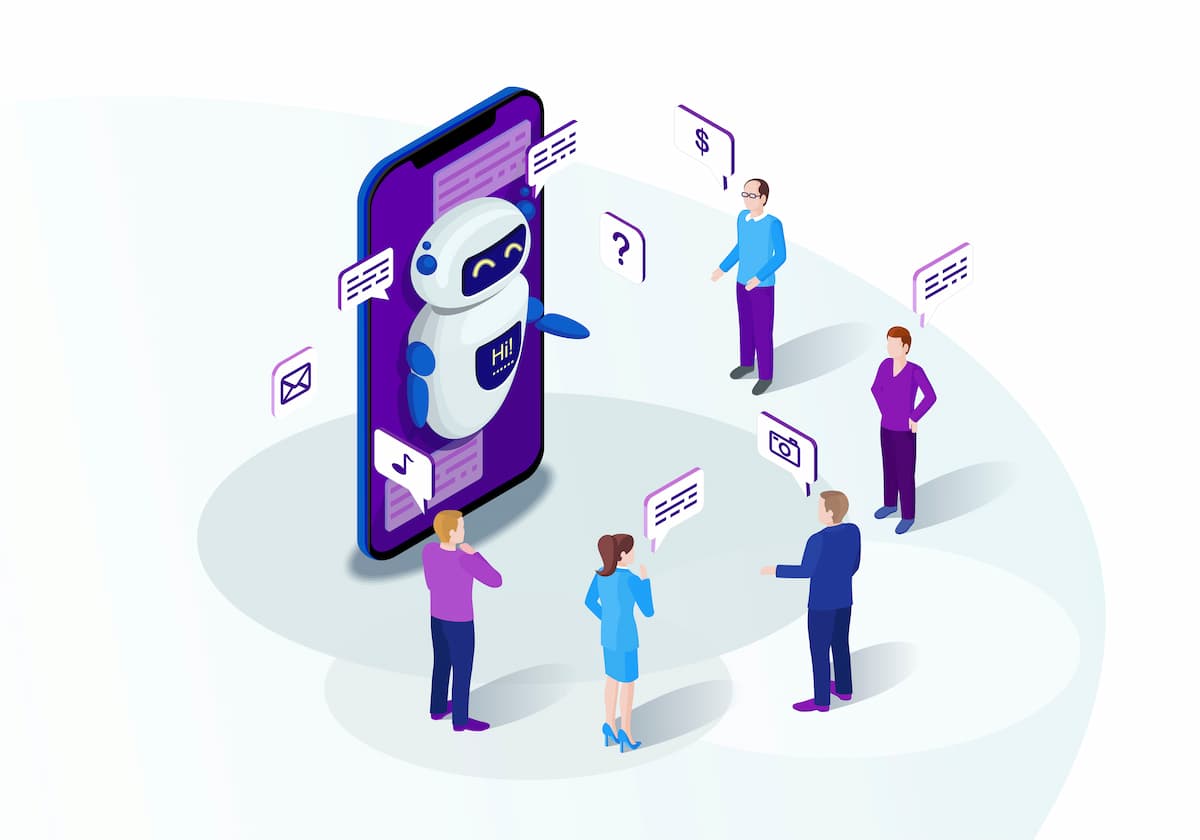Hi there! Welcome! How can I help you today?
Most people are very familiar with the prevalence of the customer service chatbot, even if they are unaware of the terminology. The friendly and smiling text boxes that pop up on the right-hand side of the screen are a software application based upon a set of predetermined language cues and rules firmly rooted in context. The term “chatbot” was added to both the Cambridge and Oxford dictionaries and is considered a mainstream linguistic term rather than internet jargon.
The first friendly bot was created back in 1966, named ELIZA; however, the term chatbot or “chatterbot” wasn’t coined until much later, in 1994. Interestingly, nearly all modern chatbots are based on the template and concept of ELIZA.
Benefits of Using Chatbots and AI in Customer Service
So, what is the point of millions of companies developing their own ELIZA, Alexa, or fun emoji character who greets and assists website traffic? Chatbots can perform a wide variety of tasks for data-savvy companies. First and foremost, they collect user information and data quickly; typically, customers who interface with the tool visit the website for a specific reason.
It is both productive and efficient not to pay an employee to monitor a chat window or man a telephone line. With the cost-savings of outsourcing this front-door interaction, those funds can be allocated elsewhere to align better with company growth plans.

Another excellent efficiency of chatbots is that companies now have 24/7 availability, and in turn, they also have 24/7 access to their customers. Manned telephones are often run on typical office working hours, which isn’t always convenient when your customers also work 9-5 shifts. Chatbots can support clients who need after-hours customer support – a large percentage considering most people would rather enjoy their lunch break than spend an hour on hold!
Support chatbots are fantastic marketing and sales tools and utterly customizable to boot. More sophisticated AI-powered chatbots like Siri, Google Home, and Alexa have entire marketing teams dedicated to keeping their content relevant and funny. Often, their content is carefully curated to go viral. This term means their content is shared explosively on social media, and the content and message promote itself. For such high-profile AI bots, celebrity partnerships and high-end brand collaborations are another way for fortune 500 companies to reach their intended audiences.
There is nothing worse than needing something simple and having to wait on hold, often listening to terrible elevator music, to receive the answer to your question. Chatbots greatly alleviate the pain of waiting on hold, should they be able to address and direct your inquiry. This will naturally enhance the guest and user experience and lead to satisfied (and returning!) customers.
Regarding content distribution, bots are super helpful here, from relationship building to customer satisfaction, which lends itself to repeat business.
Challenges of Using Chatbots and AI in Customer Service
Sometimes there is an issue that is out of the ordinary list of scenarios or which simply has additional elements that require an experienced human agent. Quite often, in these scenarios, dealing with an automated telephone bot can be stressful and annoying.
Most of these systems have a pre-set list of criteria they must run through before you are transferred to an agent, which is a guaranteed method of slowly raising a customer’s blood pressure. Additional frustration is quickly added if an incorrect button or answer is given, and the chatbot simply has to start at the top of its list again.
This lack of human touch and empathy can certainly frustrate callers. In particular, this would not be ideal for clients who have experienced poor customer service and are seeking remediation or compensation.

Frost Bank in Texas bases some of its marketing campaigns on NOT using much AI throughout their banking, having manned phone lines 24/7, and an actual live agent typing on their help chatbot – an interesting case study. The bank is frequently awarded for customer satisfaction, which does lend itself to the concept that some industries require a more hands-on approach to taking care of their customers, especially when managing their money.
Since the majority of companies’ customer-based demographic DNA is likely varied and diverse, there is an opportunity for chatbots to miss the mark or not represent the values of all customers. Quite often, marketing teams work on campaigns for bots, and some of those campaigns go viral for the wrong reasons.
A short-sighted Alexa UK campaign in 2022 for Black History Month was widely condemned for featuring white influencers and content creators to promote the campaign. The seemingly short-sighted error led to an immense backlash, and as a result, the great intention of the campaign focus was blurred upon execution.
There are many risks when handing over personal data online. Banks repeatedly warn customers that they will never ask for PINs and other confidential information via text or email, but what about chatbots? The friendly pop-up poses several data security risks: the chance of malicious malware posing as a chatbot is a worrying trend. Similarly, once the data, such as credit card information for purchasing and bill payment, is extracted, where it is contained is another serious concern for consumers.

Ensuring that a chatbot rollout is successful and continues to benefit a company definitely requires upfront capital and continued maintenance and upgrades for the service to be truly beneficial for a company to invest customer service costs into them. As discussed previously, alongside the material the chatbot draws from, the cyber security costs and efforts to mitigate them must be kept at the forefront of marketing funding.
Best Practices for Implementing Chatbots and AI in Customer Service
Should a company wish to implement an AI chatbot, it is best to have an extensive and specific list of clearly defined goals and objectives of what you want your chatbot to accomplish to succeed.
The set of questions and rules that make up their knowledge base needs to be accurate, comprehensive, and regularly updated to keep up with process and product evolution. Similarly, not only is the content continually refreshed, but the security and software used to deploy the chatbot must be continuously updated and monitored to ensure optimal chatbot functionality and the security features are maintained.
When selecting or designing an AI customer service chatbot character, that persona must be carefully representative of the company’s values and encompass the attitude and appearance of someone who would greet customers walking through the front door of your building.
The application must be user-friendly and logical; similarly, it should be easy to dismiss from the screen should the customer wish to browse the website without assistance. As outlined earlier, the most successful interchanges with a chatbot platform are an easy pathway to a real-life person should the customer have a more complex issue or question not outlined in the logic behind the conversational chatbot. This significantly eases the transactional element of the exchange and leads to happier clients!
Applications of Chatbots and AI in Content Distribution
Chatbots add tremendous value to companies and consumers through their ability to monitor customer requests in real time. This data can be reviewed, and the basis of company content can be shaped through the evaluation of this data. The successful use of a customer support chatbot must be two-fold, the customer interaction on the front end and the back-of-house analysis of this data once the exchange is complete.

AI companies use terms such as hyper-personalization of chatbots and tools as AI technology marches forward. The best chatbot technology should be able to decipher possible customer needs based on IP address, basic demographic, and past interactions to make autonomous and specific content suggestions.
Do you ever notice that your social media adverts are suspiciously targeted toward your current personal life or situation? Companies are compiling data about you based on past purchases or your age/demographic and pushing targeted advertisements. This clever technique is massively successful in delivering targeted and specific products to your direct attention.
Although FAQs are not always the star of the show, the power of frequent search term analysis should not be ignored. Knowing your customers’ recurring questions and keywords can drive and optimize SEO informing the lead analysis strategy to ensure consumers get what they need quickly.
FAQs
What types of customer service inquiries can chatbots handle?
Like most automated software, chatbots need to be based on logical content. Simple questions that have clear and definitive answers are best and should lead consumers to a solution or have the ability to lead them to a real person quickly.
How do chatbots and AI improve content distribution?
Through comprehensive analysis of user data, content can be curated based on the real-time analytics of your typical user’s wants and needs.
Can chatbots and AI replace human customer service representatives?
No. Chatbots are widely perceived as another tool in the toolbox for customer service departments rather than a stand-alone solution or replacement for a human agent.
How do companies ensure data privacy and security when using chatbots and AI?
Companies have to invest in the cyber-security and monitoring of their websites to ensure that their data is not compromised by third-party malware. As much OPEX spent on maintenance and upgrades of the features should also be spent on security.
What is the cost of implementing chatbots and AI in customer service and content distribution?
The cost of implementing chatbots and AI varies hugely depending upon the purpose of the tools and the size of the marketing department analyzing and utilizing the data on the back end.
Conclusion
When used correctly, AI-powered chatbots can be hugely beneficial for companies; however, keen and current marketing strategies must be put into place before deploying the tools. An AI chatbot is no replacement for a real live agent and problem-solving and must be considered a helpful add-on rather than a solution for a customer service team.

